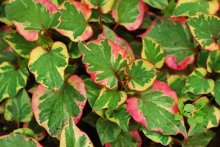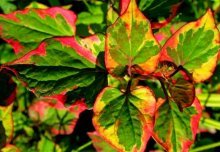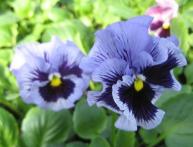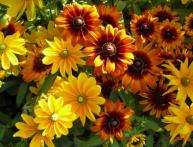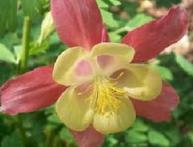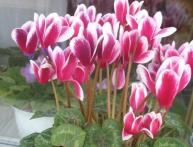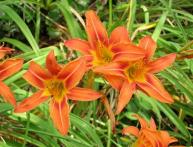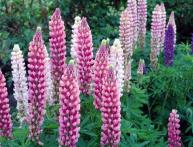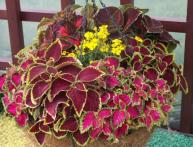Houttunia - a colorful guest in the garden
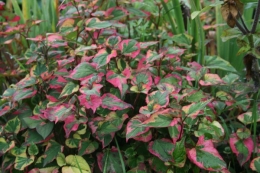
The modern art of landscape design does not stand still. Every year, when decorating gardens, new varieties, hybrids and even new species appear. Modern garden designers and simply amateur gardeners have to deal with landscaping in a wide variety of areas. Sometimes you want to know more about a plant you heard or saw. So, relatively recently, gardeners began to use the houttunia plant; perhaps many have already met it in their home or summer cottages, but have not heard its name. Let's try to find out more about this plant.
Content:
- Houttunia aka hauttyunia, general information
- Houttunias in garden design
- How to grow hauttunia in the gardenat
Houttunia aka hauttyunia, general information
Houttunia is a plant from the Savuraceae family, its homeland is the countries of Asia and the Atlantic coast of Mexico and the USA. The plant was called lizard-tail by K. Linnaeus himself, because of the similarity of the inflorescence to the tail of a lizard. The life form of Houttunia is a perennial herbaceous plant. It has long white roots that look like laces stretching horizontally in the top layer of soil. The ground part is represented by low, from 30 to 60 cm, stems of reddish shades. Houttunia leaves are similar in shape to linden leaves. The leaf blade of wild species is green with a transition to the center of the leaf into dark green streaks.
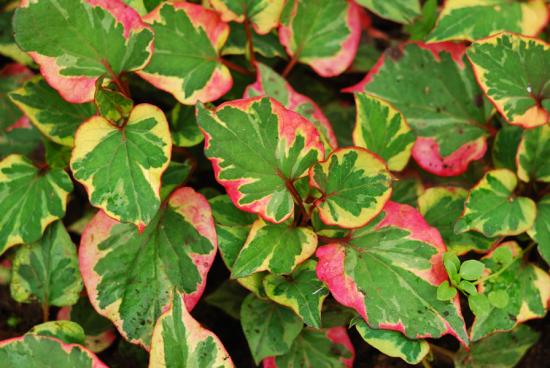
The inflorescence of the plant is modest, similar to a miniature corncob, sometimes decorated with several stipules.In the wild, it prefers to grow near water bodies and in very wet places. In China it grows in rice paddies, as it is difficult to breed weed. In the medicine of Japan, China, and Vietnam, it is considered one of the universal medicinal herbs. It is used in the treatment of:
- hemorrhoids
- swelling
- skin tumors
- abscesses
- swelling
- snake bites
Also in these countries, salads and other dishes are prepared from houttunia. A characteristic feature of the plant is a strong fishy smell. It appears when any part of the plant is broken. The smell is compared to the smell of an unwashed dog (dog), and the people of Vietnam call the plant fish mint. However, such a piquant feature was not an obstacle to growing houttunia in gardens as an ornamental plant.
Houttunias in garden design
Wild growing Houttunias look quite modest compared to cultivated varieties. The main charm of which is, first of all, the colorful and variegated foliage. Most varieties are derived from Houttunia cordata and the most common of them are:
- Chameleon - up to 20 cm in height, on the leaves green, pink and yellow colors are distributed in uneven fragments.
- Tricolor - 45 - 60 cm in height, leaves are variegated, heart-shaped, petiolate, inflorescence with four white bracts.
- Variegata - distinguished by the most elegant leaves with red, green, cream and yellow stains.
- Plena - has numerous flowers with double white bracts.
The first and absolute purpose of all varieties of houttunia is the design of garden ponds. Moreover, along the edges of large reservoirs you can plant it directly into the ground. It is important to limit its spread throughout the garden; in the reservoir itself it will grow only in shallow water.Along the edges of small ponds created using plastic factory molds, houttunia can be grown in containers, this will also limit its spread throughout the area.
Video with garden design options:
In appearance and growth pattern, Houttunia is a typical ground cover plant. She quickly develops the proposed territory. In addition, bright leaves look great in the trunk circles of standard plants and medium-sized conifers with a pyramidal crown. Windows decorated with this flower in paving paths look original. By planting it in a specially left window in the middle of solid stone or concrete, you can get a bright decorative spot. In addition, its space will be limited by a hard surface.
With properly composed soil, houttunia is an excellent plant for garden compositions such as rock gardens and alpine slides. For novice gardeners, it is more convenient to grow such an aggressive plant in a container, flowerpot or limited flower beds. Boxwoods, irises, and a variety of decoratively trimmed plants can be planted nearby. Despite the sufficient vitality of this representative of the flora, it still needs to create certain conditions for growth.
How to grow hauttunia in the garden
When growing any plant in the garden, it is important to observe several conditions, and all varieties of garden houttunia are no exception. You should pay attention to:
- lighting
- soil composition
- watering
- feeding
Lighting and soil
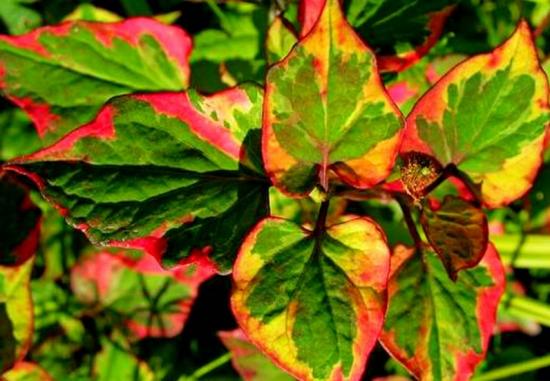
The main advantage of this plant is the beautiful color of the leaves. With a lack of lighting, the leaves lose their variegation and variety of shades. The main color of the leaves becomes green.The best lighting for her will be not only direct light for 5-6 hours, but also slightly diffused sun and a little shade. To the composition soil the plant is not demanding; it thrives on loam mixed with peat in equal quantities. Does not tolerate excess nitrogen.
Watering and fertilizing
Considering that the plant needs to maintain sufficiently high soil moisture, the flower needs regular watering. This applies to those flowers that are far from the pond and (or) grow in containers. Depending on the weather, in summer you need to water once every two to three days, avoiding the soil from drying out.
At the beginning of the growing season, plants are fed with long-lasting fertilizer. For planting in the garden, either cuttings are taken or the rhizome is divided into fragments.
It is better to do this at the beginning of summer; they are planted in the ground to a depth of 7-8 cm. It is important to limit the space for this plant and bury a barrier made of rot-resistant material, plastic or iron, into the ground. IN winter period frosts pose a danger only to houttunia planted in shallow water. In all other cases, the plant can withstand winter frosts well. Disadvantages include late germination after harsh winters. In all other respects, growing houttunia will not cause much difficulty.
Interesting information about the vegetable garden

